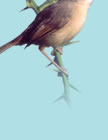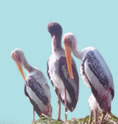
|

|
Bird Migration
The Indian sub-continent is host in winter to a multitude of birds which have nested
further north in Asia, and migrate over the mountains to seek congenial winter quarters.
Some species, such as Rosy Starlings, migrate in large flocks over quite narrow
routes, but most migration is less obvious, and often takes place at night. Summer
visitors are inland migrators, like Pittas and Golden Orioles.
What stimulates a bird to migrate?
The urge to migrate at the appropriate seasons is evoked by both external and internal
stimuli. One of the primary external stimuli is the variation in day length. The
internal stimulus seems to be provided by the breeding conditions.
What determines the goal of a migratory journey?
Birds not only return to the same general locality for breeding year after year,
but often also to the identical nesting site. Day flying migrants maintain their
course from the angle the sun makes with the earth at the appropriate season, while
nocturnal migrants are guided by the by the major constellations of stars. Once
the goal is roughly reached there seems every likelihood that landmarks, imprinted
on the senses in some way as the result of previous experience and association,
may play their part in guiding old birds to their former haunts with such astonishing
precision.
Velocity and Altitude of migratory flight
The average cruising speed of ducks and geese has been found to be between 65 and
80 km.p.h. A bird’s flying day (or night)ranges from 6 to 11 hours. Average km known
to be covered in a ‘hop’: Coot 250 km; stork 200 km ( 6 hrs); woodcock 400-480 km;
plover 880 km(11hrs).
Non-stop flights of at least 3200 km across open sea are undertaken by the Eastern
Golden Plover which is a winter visitor to India too. There are others, especially
among the shore birds or waders, that cover enormous stretches without halting for
rest or food. Except when the birds have to cross lofty mountain barriers, they
fly chiefly under 400m and only rarely over 900 m above the ground.
|

|
|

|

